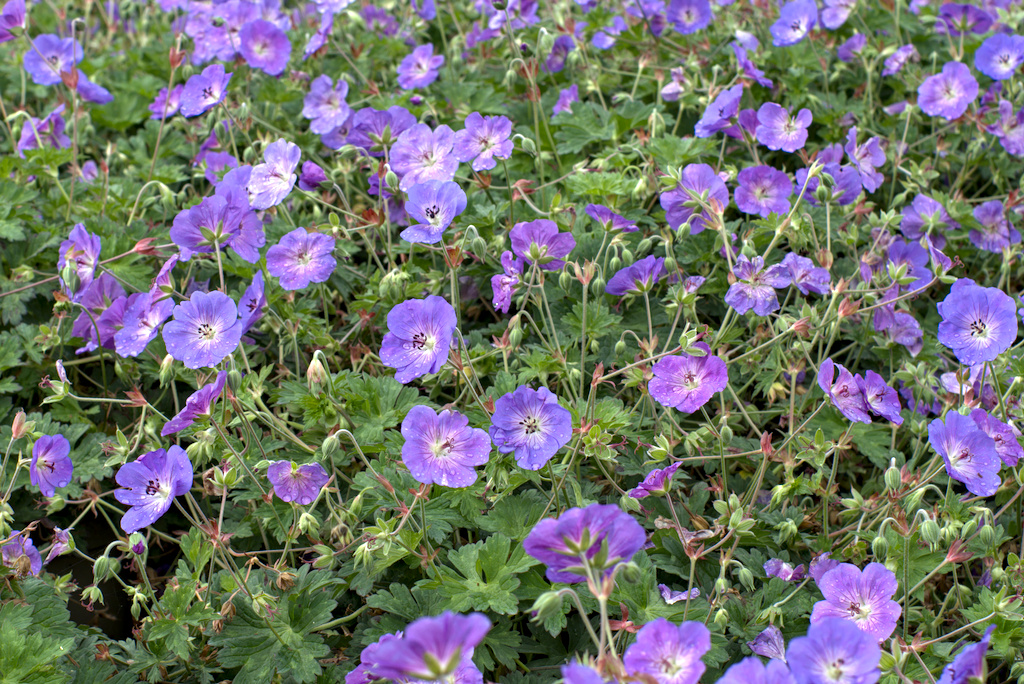Please click here to access the main AHDB website and other sectors.
- Home
- Knowledge library
- Bacterial leaf spot of hardy geranium
Bacterial leaf spot of hardy geranium
Bacterial leaf spot of hardy geraniums is caused by Xanthomonas hortorum pv. pelargonii. These pages provide information on the symptoms, pathogen, biology and control of this pathogen relevant to UK growers.
This information was last updated in 2023.
 S J Roberts
S J Roberts
Flowering geranium
An important disease of geranium
Hardy geraniums (true Geranium spp. and hybrids) are widely grown herbaceous perennials. Bacterial leaf spot (Xanthomonas hortorum pv. pelargonii) causes significant problems for commercial production of hardy geraniums. Affected plants have poor appearance, reducing marketability and hence profitability for commercial production nurseries.
Key points
- Bacterial leaf spot of hardy geraniums is caused by Xanthomonas hortorum pelargonii (previously Xanthomonas campestris pv. pelargonii) (Xhp) .
- Dark or black angular spots on leaves sometimes with a coloured halo. Dry V-shaped sectors.
- The primary source of inoculum is the mother plants, and previously infected plants on the nursery.
- The disease is disseminated with contaminated or infected cuttings and young plants.
- Local plant-to-plant spread is mainly via water-splash or aerosols from rain or irrigation.
Recommendations for hardy geranium growers
- Xhp can still be present on plug plants in the absence of symptoms.
- Growers should press young plant suppliers for assurances of the health status of plug plants.
- Quarantine and carefully check bought-in plants for the presence of symptoms, on arrival and for the next few weeks; reject the entire batch if there are symptoms on any plants.
- Grow batches from different sources as far apart as possible.
- Do not mix batches of over-wintered and current season's production on the same beds.
- Use as wide a plant spacing as economically possible.
- Avoid or minimise overhead watering: use drip or capillary irrigation systems.
- Minimise the movement of people, equipment, and machinery within and between crop batches especially when plants are wet.
- Wash/disinfect hands when moving between different batches.
- Clean and disinfect cutting and pruning tools frequently.
- Carry out trimming and pruning during dry weather and when it is forecast to remain so for a few days after the operation.
- Remove and destroy plants showing symptoms. This is particularly important with batches that remain unsold due to presence of disease – get rid of them quickly!
- Do not overwinter material that is known to be infected.
- Clean and disinfect beds / growing areas after each batch, especially if they were infected.
Recommendations for propagators
- Keep stock plants separate from production.
- Grow mother-plants under protection with sub-irrigation.
- Test parental material for the presence of Xhp; discard any that are positive.
- Only propagate from plants which are known to be free from Xhp.
- Do not propagate from parental material where any have visible symptoms.
- Clean and disinfect hands, secateurs/knives, trays, benches between different stock plants and batches.
- Do not mix material from different sources.
- Do not assume that micro-propagated material is pathogen-free.
- Grow plug plants using a sub-irrigation system.
Symptoms and biology
Find out more about the symptoms of this disease and how to identify it, as well as its epidemiology.
Prevention and control
Bacterial diseases are very difficult to control once disease has become established in a crop and symptoms are widespread. The best means of control is prevention through the use of clean (pathogen-free) propagation/planting material and good nursery hygiene.
Useful links
Research project CP 174: Review of bacterial pathogens of economic importance to UK crops
Research project CP 191: looking at Improved Management of Bacterial Diseases in Horticultural Crops
Final report for research project HNS 91: Bacterial diseases of HNS: Chemical control
Read the reports: Project HNS 178 Bacterial diseases of herbaceous perennials
Author
Dr Steven J. Roberts, Plant Health Solutions Ltd., Warwick, UK.

